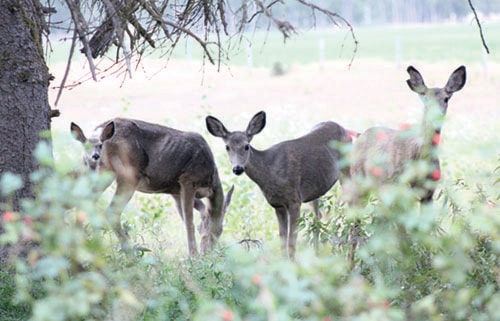Rebecca Watson
Caledonia Courier
Leaves are turning, the air is crisp and the number of wildlife vehicle collisions will start to increase across the province.
According to the BC Ministry of Transportation, October and November are peak times of the year for deer and vehicle collisions meaning soon, deer will be seen in higher numbers on roadways as we approach the high-risk time of year for many areas of the province including Fort St. James, Vanderhoof and Prince George.
Gayle Hesse, a conservationist for the BC Conservation Foundation in the Wildlife Collision Prevention Program, says deer find the road attractive for many reasons.
“Surprise, animals are not people. We tell our kids not to play on the road but animals don’t see the danger,” said Ms. Hesse. “The roadside is really good for animals to browse along. It’s full of willow and shrubs that get mowed and then regrows with tender young [tasty] growth.
They may also see a vehicle and not recognize it as danger because they perceive their surroundings differently. They don’t think the same way people do and they don’t react the same way people do.”
In the Nechako Region there are about 25 to 30 wildlife vehicle collisions/month during peak months - almost one per day. There are about 200 wildlife collisions confirmed annually for the region however, MoT estimates that for every one carcass they recover another three animals are hit and killed by vehicles. The animal may not have died right away and moved away from the road, another animal may have come and recovered the carcass, a driver may have removed it from the road or vegetation may have taken over. Factoring in the 1:3 ratio would mean an additional 600/year for a total of 800 animals killed/year in the Nechako Region.
Common factors that associate roads with high numbers of wildlife vehicle collisions include good habitat and forage, water sources nearby, and long, wide, straight stretches of road. Although the first two are obvious, the last one may not be but collisions occur more than expected on long stretches because people feel safe and tend to speed up, said Ms. Hesse.
“Any collision occurs more frequently and with more severity when the vehicle is moving faster,” said Ms. Hesse.
Another contributing factor is that deer tend to travel in herds. If you see one deer there is almost always another deer somewhere else around. In the winter especially, it can be common to see 10-20 deer together since they are a social creature and spend time in the same area.
“If you see a deer on the road try to shift your vision from the deer you see to the one that is almost certainly following behind it,” said Ms. Hesse.
It is also not uncommon to see a deer bolt out at the last second or to run toward the vehicle in a dodging or twisting motion. This is how they are ‘programmed’ to respond to a threat in an attempt to throw off the predator. A first reaction may be to swerve but that could mean the car is forced off the road or into another vehicle. With deer it may be safer to use the breaks instead of the wheel. A collision with a moose, which can weigh up to 500 kgs (1,200 lbs), carries a much higher risk of injury or death, so it will almost always be safer to swerve out of its way.
“Moose are very dangerous because they are very big animals. They have big legs so the car tends to hit their legs and the moose will crash right down on the car. Deer are low, same with bears. They are heavy but have short legs so if you crash into them they don’t generally fly up over the car,” said Ms. Hesse.
If hitting a moose is inevitable, duck down as low as you can in the car. To avoid collisions altogether, one can practise safe driving standards such as wearing a seatbelt, reducing speed in signed areas, having a clean windshield and honking the horn or flashing lights to scare animals off the road (which may work for deer but not usually for moose).
